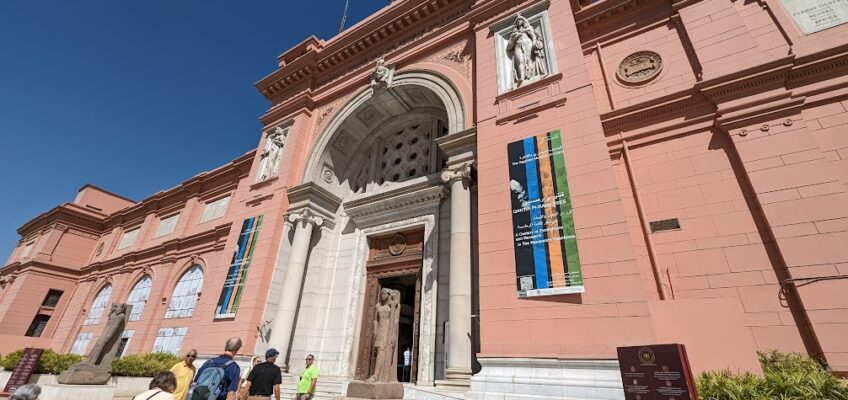The main item on yesterday’s agenda was a visit to the Egyptian Museum.
We started off with an orientation meeting at our hotel, where Mohamed (or Mo, or Dino) gave us an overview of what to expect. And because this is my third OAT tour, I got a pin!
I’m not the champion of this tour though. There’s one guy who’s on his eleventh OAT tour. But except for him and me, everyone else is on their first.
After the meeting, we boarded a bus and headed to downtown Cairo to visit the Egyptian Museum.
What I learned at the Egyptian Museum
I confess I know pitifully little about Egyptian history. And I didn’t really do any research in advance of this trip, so the museum provided a great education. None of which I can recite without looking it up.
Ancient Egyptian pharaohs belonged to 30+ dynasties; the exact number is up for debate, as is the way they are grouped into periods. Here’s an overly simplified outline (the dates are very approximate and are all BCE):
- Early Dynastic (3000–2675): Dynasties 1–2
- Old Kingdom (2675 — 2130): Dynasties 3–8
- First Intermediate Period (2130 — 1980): Dynasties 9–10
- Middle Kingdom (1980 — 1630): Dynasties 11–14
- Second Intermediate period (1630 — 1539): Dynasties 15–17
- New Kingdom (1539 — 1075): Dynasties 18–20
- Third Intermediate period (1075 — 656): Dynasties 21–25
- Late period (664–332): Dynasties 26–31
And for some context, Khufu, or Cheops, who built the Great Pyramid of Giza (which we’ll be going to see today) belonged to Dynasty 4. Amenhotep IV, also known as Akhenaten, was the tenth ruler of the 18th Dynasty. He and his son Tutankhamen (King Tut) ruled in the 14th century BCE. If there were ever Hebrew slaves in Egypt (something which historians are divided on), the exodus described in the Bible would have been roughly in 1440 BCE, and they would have been there long after the pyramids of Giza were built.
In 332 BCE Alexander the Great conquered Egypt. The Ptolomeic era followed Macedonian rule and was in turn followed by the Roman and Byzantine eras, lasting until the 7th century CE.
What I saw at the Egyptian Museum
Most ot the work in the museum, at least what we saw, came from the Old Kingdom up to the New Kingdom. It’s astonishing to me that the work spans fifteen centuries, and I’d be hard pressed to describe any particular characteristics of the different periods. How odd when you consider that from the Renaissance to now is just six centuries, and we divide that into so many periods of art history.
Here are some highlights. All my photos from the museum are here.
I find the comparison of this false door with the earlier one to be fascinating. There were a number of instances where you could see two kinds of sculpture. In some cases, such as this one, the carving is three dimensional, higher than the backround, whereas the earlier false door has carving into the stone. I’m not enough of an art history scholar to know how to describe this better. Sorry!
There are so many more interesting things I could say about the work in this museum. But it’s about time to leave to go see the pyramids. Check out the photo album.
It’s supposed to be 101 today. Tomorrow we go to Luxor, where it’s supposed to be 111. Yay!


Abby
Wonderful, comprehensive information and photos. Thanks.
Timothy Welch
Thank you for the brief and concise information! Great photos. I look forward to the next entry.